- Accueil
- Pages cachées
- 04 MARS 2024 NEWS
04 MARS 2024 NEWS
INSTITUT SUPERIEUR D'ANTHROPOLOGIE
INSTITUTE OF ANTHROPOLOGY
ONLINE COURSES / COURS A DISTANCE
INSCRIPTIONS OUVERTES
REGISTER NOW
ITALIE -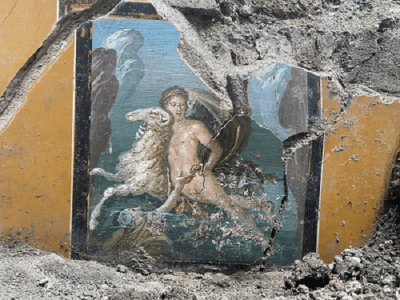 - Pompéi - Archaeologists excavating a house adjacent to the House of Leda in Insula 6, Regio V, in the ancient Roman city of Pompeii have unearthed a fresco depicting the Greek mythological siblings Phrixus and Helle (also known as Ellie). The unearthed fresco depicts two refugees at sea from ancient Greece, Phrixus and Elle, brother and sister who flee their home after being driven out by their stepmother, who has bribed Delphi’s oracle to have the children killed in order to end the famine that has befallen their homeland. The two siblings are rescued by Hera, and they escape on the Golden Fleece ram. Elle slips from the ram and drowns in the strait between Europe and Asia (named after her, or the Hellespont). In the fresco, she is seen disappearing into the waves, while her brother Frisso survives. It is “a fresco in an excellent state of preservation,” as Archaeological Park director Gabriel Zuchtriegel put it, depicting “a myth typical of ancient Greece, but also of Pompeii, where Greek myth is very much present in all homes and is also an example of how myth, storytelling through images, wall decoration becomes part of a lived environment like this small house, not very large, but richly decorated, which tries through the paintings to emulate, to imitate the tone of life of the elites.” The fresco is painted as if it were a framed picture, hung on a yellow wall. Others depicting still life images and several portraits of women have also been newly revealed.
- Pompéi - Archaeologists excavating a house adjacent to the House of Leda in Insula 6, Regio V, in the ancient Roman city of Pompeii have unearthed a fresco depicting the Greek mythological siblings Phrixus and Helle (also known as Ellie). The unearthed fresco depicts two refugees at sea from ancient Greece, Phrixus and Elle, brother and sister who flee their home after being driven out by their stepmother, who has bribed Delphi’s oracle to have the children killed in order to end the famine that has befallen their homeland. The two siblings are rescued by Hera, and they escape on the Golden Fleece ram. Elle slips from the ram and drowns in the strait between Europe and Asia (named after her, or the Hellespont). In the fresco, she is seen disappearing into the waves, while her brother Frisso survives. It is “a fresco in an excellent state of preservation,” as Archaeological Park director Gabriel Zuchtriegel put it, depicting “a myth typical of ancient Greece, but also of Pompeii, where Greek myth is very much present in all homes and is also an example of how myth, storytelling through images, wall decoration becomes part of a lived environment like this small house, not very large, but richly decorated, which tries through the paintings to emulate, to imitate the tone of life of the elites.” The fresco is painted as if it were a framed picture, hung on a yellow wall. Others depicting still life images and several portraits of women have also been newly revealed.
BULGARIE – 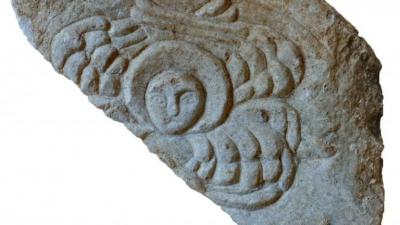
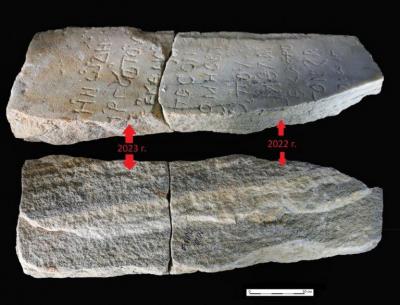
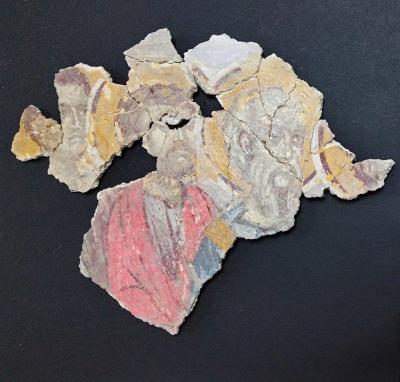 Melnik - 124 artifacts made of stone, ceramics, and metal were discovered during archaeological excavations in the Church of the Holy Mother in the town of Melnik in the Blagoevgrad province of southwestern Bulgaria. Recent archaeological excavations have unearthed treasures that connect fragments of history, providing a glimpse into the medieval and early modern lives of this Bulgarian town. Two in particular stand out among the findings. A second fragment of a medieval inscription from the 13th-14th centuries hints at the church’s initial construction period, while a fragment of a marble relief plate from the 18th or early 19th century, depicting seraphim, showcases the artistic and religious expressions of the time. The church under study has two main stages of construction. The first is from the ΧΙΙΙ – ΧIV century, and the second – from the middle of the 19th century. In 2023, efforts were concentrated in two sectors. First, a part of the floor of the church’s reenactment stage was revealed. The apse of the church from the 13th – 14th centuries was examined underneath, and it was determined that the total length of the previous church in this period was 17.35 m and had a single apse. Work in the coming seasons will determine precisely when the temple was first built. In the second sector, restorers worked to remove a layer of frescoes from the 13th and 14th centuries. According to BTA, It stated that as a result of the work in the National Archeological Museum of the Bulgarian Academy of Sciences (NAIM-BAS), some of the frescos were saved despite severe fragmentation.
Melnik - 124 artifacts made of stone, ceramics, and metal were discovered during archaeological excavations in the Church of the Holy Mother in the town of Melnik in the Blagoevgrad province of southwestern Bulgaria. Recent archaeological excavations have unearthed treasures that connect fragments of history, providing a glimpse into the medieval and early modern lives of this Bulgarian town. Two in particular stand out among the findings. A second fragment of a medieval inscription from the 13th-14th centuries hints at the church’s initial construction period, while a fragment of a marble relief plate from the 18th or early 19th century, depicting seraphim, showcases the artistic and religious expressions of the time. The church under study has two main stages of construction. The first is from the ΧΙΙΙ – ΧIV century, and the second – from the middle of the 19th century. In 2023, efforts were concentrated in two sectors. First, a part of the floor of the church’s reenactment stage was revealed. The apse of the church from the 13th – 14th centuries was examined underneath, and it was determined that the total length of the previous church in this period was 17.35 m and had a single apse. Work in the coming seasons will determine precisely when the temple was first built. In the second sector, restorers worked to remove a layer of frescoes from the 13th and 14th centuries. According to BTA, It stated that as a result of the work in the National Archeological Museum of the Bulgarian Academy of Sciences (NAIM-BAS), some of the frescos were saved despite severe fragmentation.
https://arkeonews.net/archaeologists-discover-fragment-of-medieval-inscription-of-church-in-melnik/
OMAN – 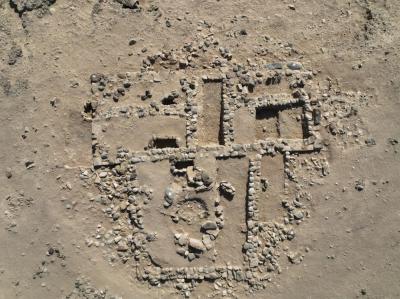
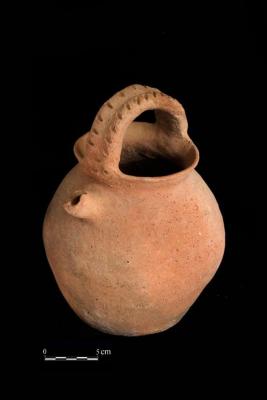 Manaqi - Archaeologists have uncovered a unique Iron Age children’s funerary building at the Manaqi archaeological site in Rustaq, South Al Batinah Governorate, Oman. This discovery, the first of its kind in the region, dates back three thousand years. The discovery is the result of joint work by archaeologists from Oman’s Sultan Qaboos University and Sorbonne University archaeologists. The discovery marks an important turning point in the understanding of funerary rituals on the Omani peninsula, as it is the first funerary building dedicated to the burial of children to be uncovered so far in the region. The ‘Manaqi’ site is one of the largest Iron Age settlements in the South Al Batinah Governorate. The excavations, conducted by the Department of Antiquities in collaboration with a team from Sorbonne University in Paris and overseen by the Ministry of Heritage and Tourism, wrapped up their first season in February. Excavations are expected to continue over the next five years. Following a preliminary site survey conducted by the joint archaeological team, two buildings, S1 and S2, were chosen for excavation during the first season. Building S2, which stood out from the other buildings in the settlement with its unique T-shaped geometric plan, was especially noteworthy. Archaeological excavations within and around the building revealed over thirty children’s graves, including newborns. This distinguishing feature raises questions about the motivations and beliefs that led to the allocation of a separate building for the burial of children in that era, which contradicted the funerary customs prevalent in the Iron Age. The discovery of a large number of residential buildings, in addition to many cemeteries, spread over a wide area of the site and several defensive towers have been interpreted by archaeologists as an indication of the major and central role the settlement played in the region in the 1st millennium BC. Among the artifacts discovered were jars with basket-shaped handles and a rare piece of pottery adorned with a seal print depicting two men.
Manaqi - Archaeologists have uncovered a unique Iron Age children’s funerary building at the Manaqi archaeological site in Rustaq, South Al Batinah Governorate, Oman. This discovery, the first of its kind in the region, dates back three thousand years. The discovery is the result of joint work by archaeologists from Oman’s Sultan Qaboos University and Sorbonne University archaeologists. The discovery marks an important turning point in the understanding of funerary rituals on the Omani peninsula, as it is the first funerary building dedicated to the burial of children to be uncovered so far in the region. The ‘Manaqi’ site is one of the largest Iron Age settlements in the South Al Batinah Governorate. The excavations, conducted by the Department of Antiquities in collaboration with a team from Sorbonne University in Paris and overseen by the Ministry of Heritage and Tourism, wrapped up their first season in February. Excavations are expected to continue over the next five years. Following a preliminary site survey conducted by the joint archaeological team, two buildings, S1 and S2, were chosen for excavation during the first season. Building S2, which stood out from the other buildings in the settlement with its unique T-shaped geometric plan, was especially noteworthy. Archaeological excavations within and around the building revealed over thirty children’s graves, including newborns. This distinguishing feature raises questions about the motivations and beliefs that led to the allocation of a separate building for the burial of children in that era, which contradicted the funerary customs prevalent in the Iron Age. The discovery of a large number of residential buildings, in addition to many cemeteries, spread over a wide area of the site and several defensive towers have been interpreted by archaeologists as an indication of the major and central role the settlement played in the region in the 1st millennium BC. Among the artifacts discovered were jars with basket-shaped handles and a rare piece of pottery adorned with a seal print depicting two men.
https://arkeonews.net/iron-age-childrens-a-unique-funerary-building-discovered-in-oman/
PANAMA – 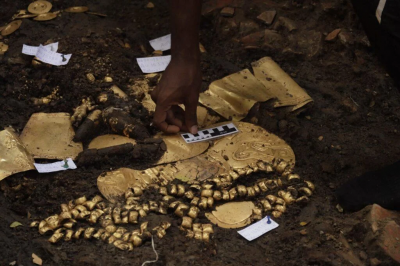 El Caño - n an archaeological find in the El Caño Archaeological Park, located in the district of Natá, province of Coclé, in Panama, a tomb has been discovered that sheds light on the sophisticated Coclé society of pre-Hispanic times. The tomb thought to belong to a Coclé lord and dating back to 750 CE, was found to contain a wealth of funerary offerings, including ceramic and gold artifacts. The El Caño Archaeological Park is well-known for its necropolis of tombs and stone monoliths that date back to 700–1000 CE. American explorer Hyatt Verrill first realized the importance of the site in 1925 when he discovered ancient monoliths beside the Rio Grande River. The tomb’s contents, consisting of 5 pectorals, 2 belts of gold beads, 4 bracelets, 2 earrings in the shape of human figures, an earring in the shape of a double crocodile, 1 necklace of circular beads, two bells, bracelets, and a skirt made with dog teeth, and a set of bone flutes, is testimony to the cultural and social wealth of the Coclé society. The collection, which probably belonged to a high-status adult male, represents a window into life and death in the Rio Grande chiefdom. The tomb, built around 750 A.D., is especially intriguing due to the presence of sacrificial attendants buried alongside the lord, indicating multiple and simultaneous burial practices. Dr. Mayo noted that the excavation process is ongoing, making it difficult to determine the exact number of individuals buried within the tomb. She said that this type of burial, known for burying a variable number of people in the same tomb, provides valuable information about the beliefs and funerary rituals of the Cocle society. Dr. Mayo explained that the Coclé lord was buried in a face-down position, a customary practice in this culture, often atop the remains of a woman. El Caño Archaeological Park, built around 700 A.D. and abandoned around 1000 A.D., has yielded significant archaeological discoveries. In addition to the known monoliths, the site includes a cemetery and a ceremonial area with wooden structures. This discovery stands out for its uniqueness and the insight it provides into Cocle society’s funerary practices.
El Caño - n an archaeological find in the El Caño Archaeological Park, located in the district of Natá, province of Coclé, in Panama, a tomb has been discovered that sheds light on the sophisticated Coclé society of pre-Hispanic times. The tomb thought to belong to a Coclé lord and dating back to 750 CE, was found to contain a wealth of funerary offerings, including ceramic and gold artifacts. The El Caño Archaeological Park is well-known for its necropolis of tombs and stone monoliths that date back to 700–1000 CE. American explorer Hyatt Verrill first realized the importance of the site in 1925 when he discovered ancient monoliths beside the Rio Grande River. The tomb’s contents, consisting of 5 pectorals, 2 belts of gold beads, 4 bracelets, 2 earrings in the shape of human figures, an earring in the shape of a double crocodile, 1 necklace of circular beads, two bells, bracelets, and a skirt made with dog teeth, and a set of bone flutes, is testimony to the cultural and social wealth of the Coclé society. The collection, which probably belonged to a high-status adult male, represents a window into life and death in the Rio Grande chiefdom. The tomb, built around 750 A.D., is especially intriguing due to the presence of sacrificial attendants buried alongside the lord, indicating multiple and simultaneous burial practices. Dr. Mayo noted that the excavation process is ongoing, making it difficult to determine the exact number of individuals buried within the tomb. She said that this type of burial, known for burying a variable number of people in the same tomb, provides valuable information about the beliefs and funerary rituals of the Cocle society. Dr. Mayo explained that the Coclé lord was buried in a face-down position, a customary practice in this culture, often atop the remains of a woman. El Caño Archaeological Park, built around 700 A.D. and abandoned around 1000 A.D., has yielded significant archaeological discoveries. In addition to the known monoliths, the site includes a cemetery and a ceremonial area with wooden structures. This discovery stands out for its uniqueness and the insight it provides into Cocle society’s funerary practices.
TURQUIE – 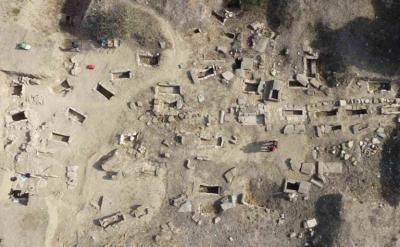
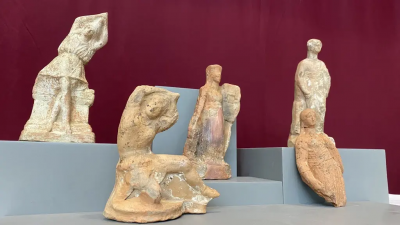 Tenedos - A 2700-year-old children’s cemetery was discovered during ongoing excavations in the ancient city of Tenedos in Bozcaada, southeast of the Dardanelles. Bozcaada (Tenedos) Bozcaada is the modern Turkish name for the legendary island of Tenedos. The name Tenedos refers to the legendary hero Tenes, who ruled the island during the Trojan War. According to legend, Tenedos was the staging station of the Greek task force under Agamemnon during the Trojan War. It was used by Xerxes as a base during the Persian War. During the 2023 excavations, many child graves were detected in the necropolis area of the city. It was noteworthy that children who died at an early age had different types of burial practices. The children were buried with their grave goods in Pithos tombs, amphora tombs, and stone masonry tombs. The most interesting of the children’s graves was a 6th century BC pithos or cube grave into which a second pithos grave was placed in the 4th century BC. Six terracotta figurines and a bronze pin in the shape of a horse’s foot were placed inside the later pithos grave. These statuettes depict two dancers wearing Phrygian headdresses, one of them a woman playing the stringed musical instrument lyre, and the remaining three standing women in Eastern costumes that can be associated with the cult of Dionysus, the Greek god of wine. Yıldırım said, “Especially in the studies carried out in the Necropolis area, an area previously unknown in the archaeological literature and limited as a burial area for children was detected. Among the graves identified in this area, the structure we defined as a pithos grave showed the feature of a pithos within a pithos and provided the emergence of data that was not previously known in archaeological data.” “The first burial here was made in the 6th century BC and then, after a period of about 200 years, a second burial was made in the 4th century BC, that is, in the Late Classical Period,” said Professor Yıldırım. Yıldırım said, “When we look at the general characteristics of the artifacts, the way they are dressed, the goddess motifs are indicative of the beliefs that prevailed in this period and the respect for children buried at a young age related to reaching God. When we evaluate these artifacts in terms of history, the stylistic and analogical features of the artifacts show that these artifacts were manufactured approximately 2,700 years ago and placed in the grave of a child who died at a young age. “We can say that the types of clothing found on the artifacts are more related to the eastern Phrygian culture and the cult of Cybele as well as Dionysus. This feature clearly shows us that this religious ideology was dominant especially in the 4th century BC in the Necropolis of Tenedos. The typological features reflected by the artifacts provide us with significant data in understanding the cultural characteristics of the Tenedos Necropolis during the Late Classical Period,” he said.
Tenedos - A 2700-year-old children’s cemetery was discovered during ongoing excavations in the ancient city of Tenedos in Bozcaada, southeast of the Dardanelles. Bozcaada (Tenedos) Bozcaada is the modern Turkish name for the legendary island of Tenedos. The name Tenedos refers to the legendary hero Tenes, who ruled the island during the Trojan War. According to legend, Tenedos was the staging station of the Greek task force under Agamemnon during the Trojan War. It was used by Xerxes as a base during the Persian War. During the 2023 excavations, many child graves were detected in the necropolis area of the city. It was noteworthy that children who died at an early age had different types of burial practices. The children were buried with their grave goods in Pithos tombs, amphora tombs, and stone masonry tombs. The most interesting of the children’s graves was a 6th century BC pithos or cube grave into which a second pithos grave was placed in the 4th century BC. Six terracotta figurines and a bronze pin in the shape of a horse’s foot were placed inside the later pithos grave. These statuettes depict two dancers wearing Phrygian headdresses, one of them a woman playing the stringed musical instrument lyre, and the remaining three standing women in Eastern costumes that can be associated with the cult of Dionysus, the Greek god of wine. Yıldırım said, “Especially in the studies carried out in the Necropolis area, an area previously unknown in the archaeological literature and limited as a burial area for children was detected. Among the graves identified in this area, the structure we defined as a pithos grave showed the feature of a pithos within a pithos and provided the emergence of data that was not previously known in archaeological data.” “The first burial here was made in the 6th century BC and then, after a period of about 200 years, a second burial was made in the 4th century BC, that is, in the Late Classical Period,” said Professor Yıldırım. Yıldırım said, “When we look at the general characteristics of the artifacts, the way they are dressed, the goddess motifs are indicative of the beliefs that prevailed in this period and the respect for children buried at a young age related to reaching God. When we evaluate these artifacts in terms of history, the stylistic and analogical features of the artifacts show that these artifacts were manufactured approximately 2,700 years ago and placed in the grave of a child who died at a young age. “We can say that the types of clothing found on the artifacts are more related to the eastern Phrygian culture and the cult of Cybele as well as Dionysus. This feature clearly shows us that this religious ideology was dominant especially in the 4th century BC in the Necropolis of Tenedos. The typological features reflected by the artifacts provide us with significant data in understanding the cultural characteristics of the Tenedos Necropolis during the Late Classical Period,” he said.
https://arkeonews.net/2700-year-old-childrens-cemetery-unearthed-in-turkeys-tenedos/
ETATS-UNIS – 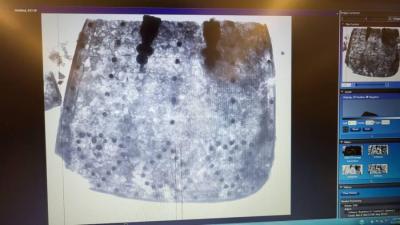 St Mary - A piece of body armor was unearthed during excavations at a 17th-century colonial fort in Maryland, a Mid-Atlantic state of the United States. While archaeologists continued their excavations in the City of St Mary’s, one of America’s premier historical sites, a project launched in 2021, they noticed a piece of metal sticking out of the dirt. According to the Washington Post, the more they dug, the more they found until they came across a slab of metal the size of a cafeteria tray. Still caked with soil and corrosion materials, the plate was identified when an X-ray revealed its rivets forming the shape of three hearts. What they found late last year was a rare piece of 17th-century armor called a tasset, which was designed to hang from a breastplate and protect one of the wearer’s thighs during battle. Originally, there would have been two — one for each leg. “The X-ray really took our breath away,” Travis Parno, director of research and collections at Historic St. Mary’s City, told All That’s Interesting in an email. “Seeing the layers of steel, the individual rivets, the hearts(!). It was a good day.” “This tasset is the second we’ve found at St. Mary’s City (the second was from a circa late-1640s context),” Parno said, “suggesting that colonists were actively making decisions about what was and wasn’t useful to be retained in their military accoutrements.” The rare piece of armor called a tasset had been brought by the first European colonists who arrived in the mid-1600s to establish one of the earliest settlements in what would become the United States. Historic St. Mary’s City, the site of the fourth permanent settlement in British North America, was Maryland’s first settlement. Founded in March 1634 on land acquired from the local Yaocomico people by newly arrived English settlers, it served as the colony of Maryland’s first capital for 60 years before being moved to Annapolis in 1694. St. Mary’s was abandoned after it was eclipsed by Annapolis and never built over, making it an undisturbed archaeological site.
St Mary - A piece of body armor was unearthed during excavations at a 17th-century colonial fort in Maryland, a Mid-Atlantic state of the United States. While archaeologists continued their excavations in the City of St Mary’s, one of America’s premier historical sites, a project launched in 2021, they noticed a piece of metal sticking out of the dirt. According to the Washington Post, the more they dug, the more they found until they came across a slab of metal the size of a cafeteria tray. Still caked with soil and corrosion materials, the plate was identified when an X-ray revealed its rivets forming the shape of three hearts. What they found late last year was a rare piece of 17th-century armor called a tasset, which was designed to hang from a breastplate and protect one of the wearer’s thighs during battle. Originally, there would have been two — one for each leg. “The X-ray really took our breath away,” Travis Parno, director of research and collections at Historic St. Mary’s City, told All That’s Interesting in an email. “Seeing the layers of steel, the individual rivets, the hearts(!). It was a good day.” “This tasset is the second we’ve found at St. Mary’s City (the second was from a circa late-1640s context),” Parno said, “suggesting that colonists were actively making decisions about what was and wasn’t useful to be retained in their military accoutrements.” The rare piece of armor called a tasset had been brought by the first European colonists who arrived in the mid-1600s to establish one of the earliest settlements in what would become the United States. Historic St. Mary’s City, the site of the fourth permanent settlement in British North America, was Maryland’s first settlement. Founded in March 1634 on land acquired from the local Yaocomico people by newly arrived English settlers, it served as the colony of Maryland’s first capital for 60 years before being moved to Annapolis in 1694. St. Mary’s was abandoned after it was eclipsed by Annapolis and never built over, making it an undisturbed archaeological site.
https://arkeonews.net/rare-piece-of-metal-armor-found-at-17th-century-fort-in-maryland/
EGYPTE – 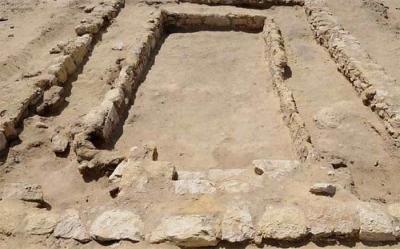 Watfa - In 2017, when the ruins of an ancient Greek gymnasium were discovered in an oasis of a desert in Egypt, archaeologists said that it was the first of its kind. The Watfa gymnasium that was used to train young Greek-speaking men in sports, literacy and philosophy was discovered by a joint Egyptian-German archeological team on the site of an ancient village southwest of Cairo in the Faiyum Oasis. The gymnasium included a large meeting hall, once adorned with statues, a dining hall and a courtyard in the main building. Surrounded by gardens, this center of Greek learning for young men in ancient Egypt also had a 200-meter (660-foot) running track, on which they trained for important 180-meter races. Watfa was founded 2,300 years ago in a small, rural village of 1,200 people – two-thirds Egyptians and one-third Greeks – by King Ptolemy II. The king named the village in Fayoum Oasis for his second sister Philotera. Philoteris was one of the new villages founded in the years after Alexander the Great invaded Egypt. Thousands of Greek-speaking settlers moved to the territory by the River Nile and built public buildings and baths which became meeting places for themselves and their Egyptian neighbors. The Hellenistic gymnasium was run by the village authorities and open to young men up to the age of 30. Women, slaves, freedmen, tradesmen, male prostitutes, drunkards and madmen were excluded. The foundations of the installation were exposed by the team led by Professor Cornelia Romer, of the German Archaeological Institute. “The gymnasium of Watfa clearly shows the impact of Greek life in Egypt, not only in Alexandria, but also in the countryside,” Romer said at the time.
Watfa - In 2017, when the ruins of an ancient Greek gymnasium were discovered in an oasis of a desert in Egypt, archaeologists said that it was the first of its kind. The Watfa gymnasium that was used to train young Greek-speaking men in sports, literacy and philosophy was discovered by a joint Egyptian-German archeological team on the site of an ancient village southwest of Cairo in the Faiyum Oasis. The gymnasium included a large meeting hall, once adorned with statues, a dining hall and a courtyard in the main building. Surrounded by gardens, this center of Greek learning for young men in ancient Egypt also had a 200-meter (660-foot) running track, on which they trained for important 180-meter races. Watfa was founded 2,300 years ago in a small, rural village of 1,200 people – two-thirds Egyptians and one-third Greeks – by King Ptolemy II. The king named the village in Fayoum Oasis for his second sister Philotera. Philoteris was one of the new villages founded in the years after Alexander the Great invaded Egypt. Thousands of Greek-speaking settlers moved to the territory by the River Nile and built public buildings and baths which became meeting places for themselves and their Egyptian neighbors. The Hellenistic gymnasium was run by the village authorities and open to young men up to the age of 30. Women, slaves, freedmen, tradesmen, male prostitutes, drunkards and madmen were excluded. The foundations of the installation were exposed by the team led by Professor Cornelia Romer, of the German Archaeological Institute. “The gymnasium of Watfa clearly shows the impact of Greek life in Egypt, not only in Alexandria, but also in the countryside,” Romer said at the time.
VIDEO = https://greekreporter.com/2024/03/03/ruins-of-hellenic-gymnasium-unearthed-in-egypt-oasis/
TURQUIE – 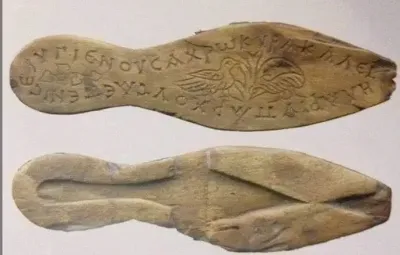
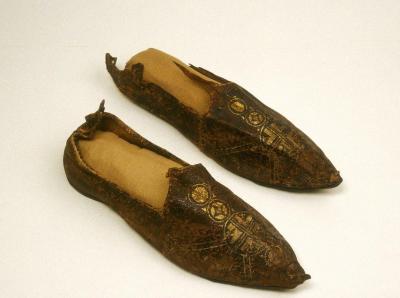 Istanbul - A pair of 1,500-year-old lady’s sandals with a sweet message in Greek was discovered during a dig in Istanbul. There is a message in Greek on them which reads: “Use in health, lady, wear in beauty and happiness.” The astonishing find was discovered during digs prompted by the Marmaray project, the undersea railway tunnel connecting the Asian and European sides of Istanbul under the Bosporus. Scientists say the sandals discovered are more than 1,500 years old, and they belonged to a woman. The Byzantines loved color and patterns, and they made and exported very richly patterned cloth, especially Byzantine silk, which was woven and embroidered for the upper classes and resist-dyed and printed for the lower. Modesty was important for all, and most women appeared to be almost entirely covered by rather shapeless clothes. There has been a considerable amount of footwear recovered in this excavation project, with sandals, slippers, and boots to the mid-calf, commonly seen in manuscript illustrations, which were also found in the dig. Many of the items are richly decorated in various ways. The color red, reserved for Imperial use in male footwear, is actually by far the most common color for women’s shoes. Purses are rarely found and seem to have been made of textile matching the dress or perhaps tucked into the sash.
Istanbul - A pair of 1,500-year-old lady’s sandals with a sweet message in Greek was discovered during a dig in Istanbul. There is a message in Greek on them which reads: “Use in health, lady, wear in beauty and happiness.” The astonishing find was discovered during digs prompted by the Marmaray project, the undersea railway tunnel connecting the Asian and European sides of Istanbul under the Bosporus. Scientists say the sandals discovered are more than 1,500 years old, and they belonged to a woman. The Byzantines loved color and patterns, and they made and exported very richly patterned cloth, especially Byzantine silk, which was woven and embroidered for the upper classes and resist-dyed and printed for the lower. Modesty was important for all, and most women appeared to be almost entirely covered by rather shapeless clothes. There has been a considerable amount of footwear recovered in this excavation project, with sandals, slippers, and boots to the mid-calf, commonly seen in manuscript illustrations, which were also found in the dig. Many of the items are richly decorated in various ways. The color red, reserved for Imperial use in male footwear, is actually by far the most common color for women’s shoes. Purses are rarely found and seem to have been made of textile matching the dress or perhaps tucked into the sash.
https://greekreporter.com/2024/03/03/1500-year-old-sandals-greek/
CHINE - Nanjing - Chinese archaeologists have discovered a path that was exclusively reserved for the emperor, as well as a magnificent gate of the ancient capital city dating back to the Liang Dynasty, one of the Southern Dynasties (420-589) in Nanjing, east China's Jiangsu Province. The researchers excavated the 210-meter-long path at Nanjing West Street site, or "Nanjing Xijie" in Chinese. About 26 meters wide, the path features trenches dug on both sides. Meanwhile, some magnificent gate ruins measuring about 33 meters wide with brick-paved drainage facilities were also discovered at the site. Chen Dahai, an associate researcher from the Nanjing Institute of Archaeology in charge of the archaeological project at the site, believes the gate to be the southern gate of Liang's capital city at that time. Additionally, a river moat was dug outside the gate and city walls of the ancient capital. Relics, including a large number of celadons -- greenish ceramics -- were also unearthed at the site. Some porcelain relics are believed to be customized products for the ancient capital city or Buddhist temples at that time, said Chen. Starting from 2017, the researchers have excavated a total of 12,000 square meters of the site, discovering new research materials for further studies on the ancient history and civilization of Nanjing.
